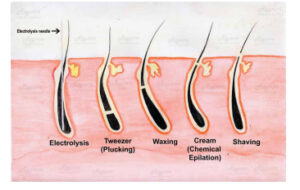razors for hair removal come with various cons that leave the skin with
bumps, skin rashes, and ingrown hair. Neither of these facilitates permanent hair
removal
Lasers, for decades, have gained popularity for effective hair removal. The perks of
using laser as a hair removal option are the ease and comfort it provides during the
procedure. The downsides associated with using lasers largely depend on skin color
and the thickness of the hair.
To be more precise, laser hair removal appears to be more effective for light-toned
individuals with thick hair. Laser light is thoroughly absorbed by thick hair follicles
which helps the hair follicle to shrink which eventually closes the pore. Perhaps, an
individual might require a minimum of 6-7 sessions for good results.
ELECTROLYSIS on the other hand is the only FDA-approved solution for
permanent hair removal. This method of hair removal uses electricity to heat up
and destroy the hair follicle. Here, both cells and the root of the hair are destroyed
and there is no new hair growth seen in the electrolysed area.

Electrolysis can be received by the patient in three different ways:
- Thermolysis: A probe is used to generate an electric current inside the hair follicle
produces heat and destroys the hair follicle. This is the most common and least
painful method of electrolysis. - Galvanic: With electric current and chemical reaction the hair follicle is destroyed
permanently provided this technique is least practiced as it is very painful. - A mix of thermolysis and galvanic: This technique is used for patients with curly and
thick hair.
Which one is better??
Laser or Electrolysis for hair removal
Lasers use light energy to heat up and target a part of the hair follicle. The entire
hair follicle is eventually targeted with every session. Briefly, LASER helps to
reduce overall hair growth but doesn’t eliminate the hairs 100 percent. The result
after laser hair removal shows thinner and lighter hair growth and further sessions
are required to completely target the hair follicle in toto.
Electrolysis, on the other hand, is backed up by the FDA as a solution for permanent
hair removal. The hair follicle under the skin surface is targeted using a thin wire. It
uses short-wave radio frequencies and attacks the hair follicle thus managing to disrupt
the hair growth cycle and preventing hair from growing. Hair removal through
electrolysis requires more sessions as it cannot cover large areas in one session.
Additionally, electrolysis is not particularly confined to any hair type or skin tone.
Whereas, the laser is bound to or we can say deliver better results in faired-skinned
individuals and ones with thick hair.


Why choose Electrolysis for hair removal?
Electrolysis proves to be very promising for patients with dark skin tones and thin
hair. Also, it is a great technique to eliminate grey hairs in which the diode lasers are
not responsive. This is because the electric rod transmits current waves which is
directly absorbed by the root of the hair eventually causing the hair to fall off.
The mechanism behind electrolysis entirely destroys the growth center of the hair and
thus preventing future hair growth in that area.
Electrolysis requires more number of sessions as it cannot cover larger areas as
seen with lasers. So if you want your hair removal to be done in a short period of
time then laser hair removal can be opted for. But with electrolysis, the results tend
to last long and are equally effective for all skin types and specifically for grey hairs.
Techniques for hair removal are many but Dr. Bhavesh Gupta here at Clinique
Internationale Kharghar is inclined more towards personally consulting the patient
to understand their skin and hair type and suggests the most suitable option for
hair removal.

